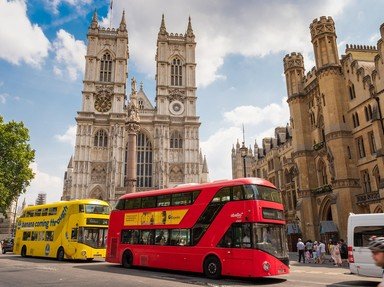Quiz Answer Key and Fun Facts
1. The huge stone tower that was at the center of William the Conqueror's fortress began being built in the 1070s. By 1100 the tower was complete and dominated the surrounding skyline of London. What is the name of this building that served as a defense, a residence, and a symbol of power?
2. In the mid 13th century, the Holy Roman Emperor Frederick II gave King Henry III of England three real leopards to match the ones on his shield. Many historians believe these were actually lions. Over the next several hundred years other exotic animals were gifted to the royals at the Tower. What was the name given to this group of creatures that local people flocked to come see?
3. There were many attacks and sieges against the Tower of London during its history. Some, like the Peasants' Revolt in 1381 were rather harmless and locals stormed the tower and ran right through an open gate! Others involved defensive weapons such as the one pictured here. What is the name of this weapon that uses force to hurl large objects at advancing troops?
4. The late 1400's saw a struggle between the royal houses of Lancaster and York to control the throne. Among the deaths and battles, there was the mysterious disappearance of two young princes who were the sons of Edward IV. They disappeared in the Bloody Tower of the Tower of London. What was the name of the war between these two fighting factions?
5. After the War of the Roses, in the late 1400s, the House of Tudor eventually emerged triumphant. Henry VIII, in his desire to divorce his first wife and marry his second, broke with the Roman church. This caused a huge amount of political and religious prisoners to crowd the Tower. Many were tortured. What device, pictured here, is used to stretch a person until their joints and bones separate?
6. A water gate was built in the late 1270s in the part of the Tower of London called St. Thomas's Tower. It was cutting edge technology for its time with construction knowledge gleaned during the Crusades, including gilded bars and arrow loops. In 1532 it had timber framing added in celebration of Anne Boleyn's coronation. Later she would enter through it on the way to her execution. What name did this entrance obtain?
7. The Tower Green saw many royally directed executions during the bloody years between 1536 and 1601. A memorial now stands to remember those that died, including Anne Boleyn, Catherine Howard, and Lady Jane Grey. How were these people put to death here?
8. Henry VII had created a group of men to guard his family and properties in the late 1400's. He called them Yeomen Warders. When his son Henry VIII moved out of the Tower of London years later, he left a group of twelve of these warders behind to ensure the safety of the Tower. The number of Yeomen Warders has gone up and down over the years. What is another term for these ceremonial guardians?
9. The St. Edwards' Crown, as seen in this picture, was made in 1661 and is placed on the head of the king or queen during coronation. This crown is just one of the royal objects that were moved to the Tower in 1669 for safekeeping and public exhibition when not being used by the monarch. What is the name of this group of 141 objects?
10. As long as the Tower has existed, with its fascinating history, so have these birds. There are six of them (plus a spare) resident at the Tower at all times. Legend says that the kingdom and Tower will fall if the animals leave the fortress. What are they?
Source: Author
stephgm67
This quiz was reviewed by FunTrivia editor
bloomsby before going online.
Any errors found in FunTrivia content are routinely corrected through our feedback system.

